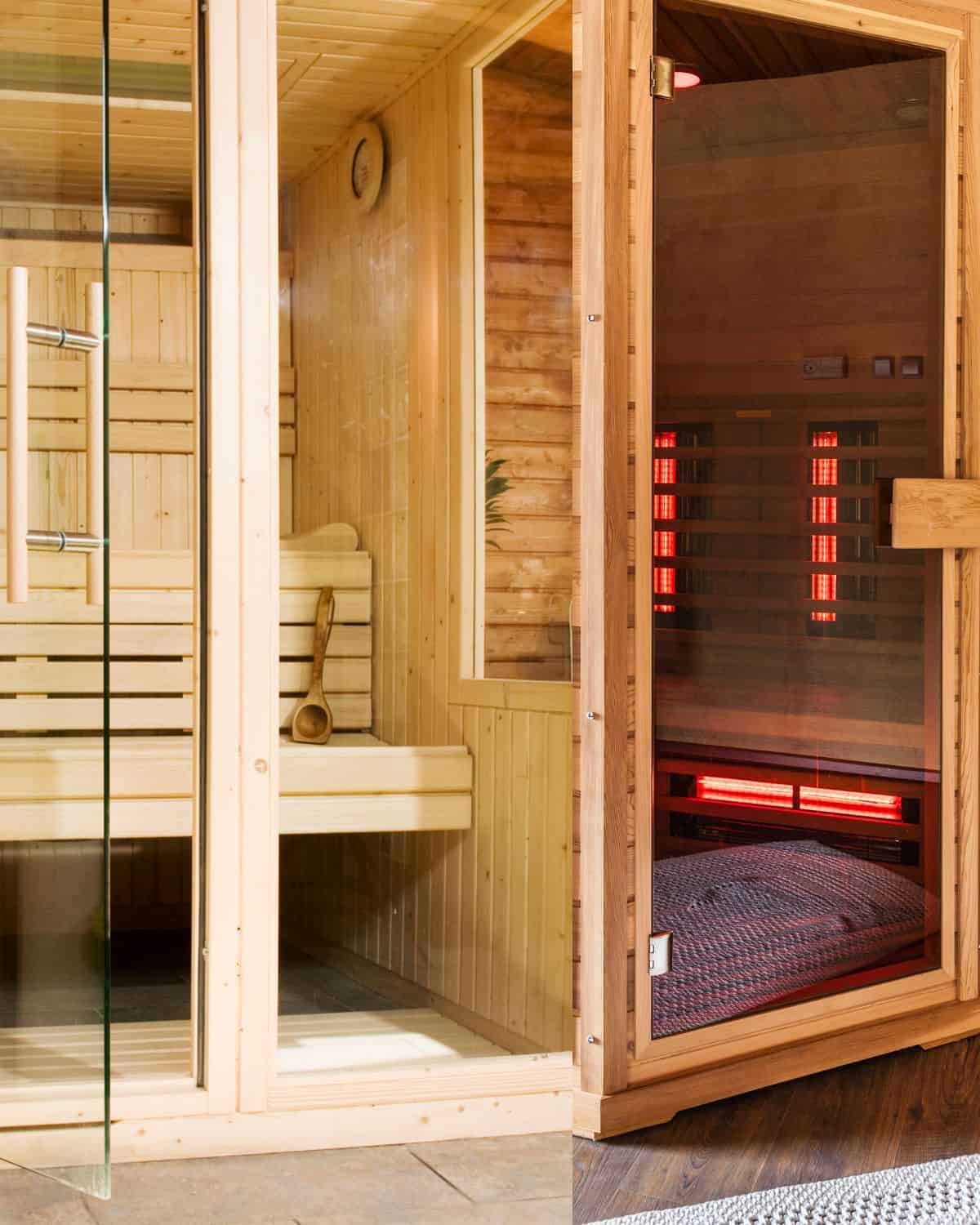Traditional vs Infrared Saunas: which is the best choice for your health and lifestyle? Discover the key differences, health benefits, and lifestyle considerations in this comprehensive guide, designed to help you make an informed decision for your wellness journey.

Jump to:
- Quick Comparison Guide: Sauna Types
- What Is Traditional Sauna: The Classic Heat Experience
- What is an Infrared Sauna: Modern Gentle Therapy
- What is a Steam Sauna: Vapor Therapy
- Why is Heat Beneficial to Your Body?
- Health Benefits of Sauna Use: Traditional vs Infrared
- Sauna Comparison: Impact on Brain Health
- Sauna Comparison: Exercise and Recovery
- Sauna Comparison: Sleep
- Which Sauna Type Suits You?
- How to Integrate Saunas into Your Lifestyle
- Recipe for Post-Sauna Sessions
- ❔FAQ
- Information Sources
Hi there! I'm Patricia, a neuroscientist passionate about understanding the role of food and lifestyle on brain health! (If that interests you check out why eating a balanced diet is important).
I also happen to be an avid sauna enthusiast! I am such a fan that a few years ago I purchased one to have at home and use it almost daily! But before that, I struggled with deciding between a traditional vs. infrared sauna. However, getting through all the marketing and overhyped information to decide which sauna would suit me best was hard work!
Which is why this guide was created! To help answer your top questions so that you can uncover which sauna type will suit you best. Oh, and I've included my TOP favorite post-sauna recovery recipes below in the recipe section 👇🏽
We'll explore the actual science behind saunas, the differences in the way they heat your body, why that matters, the health benefits, and the pros and cons of a traditional vs infrared sauna. Whether you're a sauna newbie or a seasoned sauna-goer, I hope to shed some light (infrared light, to be precise!) on this warm topic.

Quick Comparison Guide: Sauna Types
| Sauna Type | Temp. Range | Average Cost (US) | Space Needed | Heat Source | Heat Penetration | Benefits |
|---|---|---|---|---|---|---|
| Traditional Sauna | 150-195°F | $5,000 - $12,000 | Medium to Large | Wood, Electric, or Gas Heater | Surface level heat directly heating the air and skin. Promotes intense sweating. | Relaxation, Circulation, and Detoxification |
| Near-Infrared Sauna | 110-140°F | $3,000 - $8,000 | Small to Medium | Near-Infrared Lamps | Light penetrates the skin and heats the body directly. Promotes sweating but at a lower air temperature. | Increased Comfort, Easier Home Use, Cost-Effectiveness: |
| Far-Infrared Sauna | 120-150°F | $3,000 - $8,000 | Small to Medium | Far-Infrared Ceramic or Carbon Heaters | Far-infrared light penetrates deep tissue to heat the body. Promotes sweating but at a lower air temperature. | Increased Comfort, Easier Home Use, Cost-Effectiveness |
| Steam Sauna | 110-120°F | $2,500 - $10,000 | Medium to Large | Electric Heater and Water | Heats the air through steam, which increases humidity and causes the body to heat up from the moist air. Promotes intense sweating. | Surface level heat directly heats the air and skin. Promotes intense sweating. |
Saunas have been a sanctuary of relaxation, detoxification, and health for centuries. From the traditional Finnish saunas to the modern infrared cabins, they have offered solace to many seeking a break from the daily grind. But with the rise of infrared saunas, there's been a heated debate (pun intended!) about which type is superior. Infrared sauna therapy, traditional sauna, or steam saunas?
I assume you are here because you trying to decide between a traditional vs infrared sauna. You want the best for your health and well-being, and perhaps a quick session during a work break or after a hectic parenting day. Before we compare sauna types, let's understand how each one works!
What Is Traditional Sauna: The Classic Heat Experience

Integral to Finnish culture, the earliest known sauna structures date back to 7000 BC! However, these early "savusauna", as the Finns called them, were just pitts dug into embankments in the ground (1). They required a fireplace, hot rocks or stones, and water. The stones were heated in the fireplace to produce heat. Often water was placed onto the hot stones to increase the temperature inside these pits and add steam (1).
These early saunas eventually evolved into the traditional Finnish-style saunas we know today. A small wooden cabin, or room, with a fireplace (often electric) topped with stones. You can enjoy it with dry heat or add water for a steamy experience.
Regardless of how you enjoy it, traditional saunas have remained a place for physical and spiritual cleansing. They continue to play a crucial role in the life of the Finns, being used for health, relaxation, and even childbirth!
Traditional Saunas Overview:
- Heat Source and Mechanism: Traditional saunas use a heat source like a wood stove or an electric heater to warm the air inside the sauna room. This method creates a high-temperature environment to induce sweat and relaxation.
- Typical Temperature Range: The temperature in traditional saunas usually ranges from 150°F to 195°F (65°C to 90°C). This high temperature is key to the traditional sauna experience, promoting intense sweating and heat exposure.
- Benefits: Relaxation, Circulation, and Detoxification: Traditional saunas are renowned for their relaxation benefits. The heat helps to soothe muscles, improve circulation, and promote a sense of well-being. Additionally, intense sweating is believed to aid in detoxification, helping the body rid itself of toxins through the skin.
- Considerations: While traditional saunas are beneficial for relaxation and detoxification, they may not be suitable for everyone. The high temperatures can be challenging for those with certain health conditions, and it's important to stay hydrated and limit time spent in the sauna to prevent overheating.
What is an Infrared Sauna: Modern Gentle Therapy

While traditional saunas rely on heating the air around you, a modern infrared sauna takes a different approach. Instead of warming the air, they use infrared light to directly heat the body. This invisible light penetrates the skin, offering a different set of health benefits, some of which overlap with traditional saunas, while others are unique to infrared therapy (2,3). So from the jump traditional vs infrared saunas differ in how they heat your body!
Infrared Sauna Overview:
- How Infrared Rays Heat the Body: Infrared saunas use infrared heaters to emit light or infrared waves, which are absorbed directly by the skin. Infrared saunas heat the body directly, allowing for a deeper penetration of heat at a lower ambient temperature.
- Temperature Range: Infrared saunas operate at a lower temperature range versus traditional saunas, typically between 120°F and 140°F (49°C to 60°C).
- Benefits: Increased Comfort, Easier Home Use, Cost-Effectiveness: Infrared saunas are often considered more comfortable due to their lower temperatures. They are easier to install and use at home, and they can be more cost-effective in terms of both purchase price and operational costs.
- Considerations: Limited Research, Potential Marketing Influence, and electromagnetic field (EMF) Risks. Look for brands like SaunaSpace which uses a Faraday cage and has very low EMF levels. If you're new to infrared saunas, start with shorter sessions at lower temperatures and gradually increase both as you become more accustomed to the heat. Unlike traditional saunas, infrared saunas heat the body directly, which can feel more intense at first. It's important to listen to your body and adjust the temperature and duration to your comfort level.
Near vs. Far Infrared Saunas
The spectrum of infrared light consists of near-, middle-, and far-infrared wavelengths (2). Each type offers its own set of benefits:
- Near-Infrared: These wavelengths are closest to the visible light spectrum and mimic natural sunlight. The shorter wavelength can penetrate deep into your skin versus far infrared to increase your core body temperature (23). Near-infrared offers many health benefits, like muscle recovery and circulation, and has medical applications due to its deeper penetration capabilities.
- Far-Infrared: Far-infrared wavelengths have a shorter wavelength and are often absorbed by water in the body (23). This absorption can lead to a more superficial heating than near-infrared. This can be beneficial to the skin and aid in detoxification, and relaxation.
- Full-Spectrum: Some infrared saunas, referred to as “full spectrum” models, emit all wavelengths, providing a comprehensive sauna experience (2). You will get the benefits from both deep and superficial light therapy which is the way to go! Look for brands like SaunaSpace that will have both types of light.
What is a Steam Sauna: Vapor Therapy

Over the centuries, the concept of the sauna spread across the world. While the core essence remained the same—using heat to induce sweat and relaxation—but the methods evolved. Enter the steam room, a variant of the traditional sauna, where water is poured over heated rocks to produce a lot of steam, enveloping the room in moist warmth.
Traditional steam saunas, also known as steam baths, have a rich history that spans various cultures, including the ancient Greeks and Romans. The Roman bathhouses, known for their elaborate architecture, were not just places for bathing but also for socializing and conducting business. The tradition of steam bathing was also prevalent in the Russian banya and the Turkish hammam, each with its unique cultural significance.
Steam Sauna Overview:
- Heat Source and Mechanism: Similar to traditional saunas, steam saunas use an electric heater to warm rocks. Water is then poured over these heated rocks to produce steam. This steam increases the humidity in the room, creating a warm, moist environment that heats the body.
- Typical Temperature Range: The temperature in steam saunas is typically lower than traditional saunas, ranging from 110°F to 120°F (43°C to 49°C). However, the high humidity makes the heat feel more intense, providing a deeply penetrating warmth.
- Benefits: Hydration, Skin Health, and Respiratory Relief: Steam saunas are known for their hydrating effects on the skin, making them a popular choice for skincare enthusiasts. The moist heat helps open up the pores, cleanse the skin, and can aid in respiratory relief by loosening congestion. Additionally, the steam sauna experience can be very relaxing, helping to reduce stress and promote a sense of well-being.
- Considerations: The high humidity of steam saunas is not suitable for everyone, especially those with certain respiratory conditions. It's important to stay hydrated and limit the duration of each session. As with any sauna experience, it's advisable to consult with a healthcare provider before regular use, especially for individuals with health concerns.
Why is Heat Beneficial to Your Body?

Heat exposure, such as that experienced in a sauna, triggers a multitude of physiological responses in the body (4,6,7,8,9,10,13,15). When exposed to heat, your body's thermoregulatory system activates to maintain a stable internal temperature.
This process involves increased blood flow to the skin and sweating, enhancing circulation throughout the body (4, 16). The heart rate increases, similar to the effects of moderate exercise, providing a cardiovascular workout and improving cardiac function (4, 16). Additionally, heat exposure stimulates the release of endorphins, the body's natural feel-good chemicals, which can lead to improved mood and a sense of relaxation (5, 15).
Thus regular sauna sessions and heat therapy are associated with various health benefits, including reduced risk of cardiovascular diseases, improved mental health, and enhanced cognitive function, making it a valuable addition to a healthy lifestyle (4, 6,7,8,9,10,13,15).
Heat Shock Proteins:
Let's talk about one of the coolest aspects of sauna use (ironic, I know) – heat shock proteins (HSPs). These proteins play a crucial role in protecting your cells from stress-related damage. When your body is exposed to the heat of a sauna, it ramps up HSP production, which is super important for keeping cells functioning under stress. This mechanism is particularly relevant in the context of neurodegenerative diseases and HSPs can guard against diseases like dementia and Alzheimer's (16).
Traditional vs infrared sauna and HSP: Traditional saunas, with their higher temperatures, are likely to induce a more robust production of heat shock proteins (HSPs). In contrast, infrared saunas, operating at lower temperatures, may stimulate HSP production differently, potentially offering more targeted cellular benefits due to their deep tissue penetration.
Sauna Safety Tips:
Enhance your sauna experience with our essential Sauna Safety Tips. This infographic provides a quick, easy-to-follow guide to ensure your sessions are both enjoyable and safe. From staying hydrated to understanding the importance of cooling down, these tips are crucial for anyone using traditional vs infrared saunas.

Health Benefits of Sauna Use: Traditional vs Infrared
Saunas are not just a relaxing escape but a hub of health benefits. Here’s how traditional vs infrared sauna vs steam saunas differ in their health benefits:
| Sauna Type | Heart Health Benefits | Muscle & Joint Benefits | Brain/Mood Benefits | Immune System & Heat Shock Proteins |
|---|---|---|---|---|
| Traditional Sauna | Improves cardiovascular function, similar to moderate exercise 4, 6,13. | Offers relief from muscle and joint pain, ideal for recovery 6. | Linked to mood enhancement, neurogenesis, improved cognitive function, and neuroprotective effects. Research suggests a potential reduction in the risk of dementia and Alzheimer's disease 7, 17, 19, 20. | Potential anti-inflammatory effects 8. Induces a more significant production of HSPs due to higher temperatures, offering robust neuroprotection and stress resilience 4, 16. |
| Infrared (Near & far) | Mimics cardiovascular responses similar to exercise 9. Beneficial for those unable to engage in traditional exercise. | Enhances recovery post-exercise, improving neuromuscular performance and reducing muscle soreness 10. | Shown to stimulate memory ability, and affect neurogenesis and synaptic plasticity. Also linked to mood enhancement and neuroprotective effects 5,18,19,20. | Influence cortisol levels and can affect white blood cell profile 11. Stimulates HSP production, potentially offering targeted neuroprotection due to deep tissue penetration 4,16. |
| Steam Sauna | Stimulates cardiovascular responses, increasing heart rate and skin temperature 12,13. | Provides hydration to the skin and relaxation which can help reduce muscle tension. | A humid environment aids in relaxation and stress reduction, potentially enhancing mood. Direct studies linking to specific neuroprotective effects are less common 7. | Limited research |

Sauna Comparison: Impact on Brain Health
As a neuroscientist, I find the effects of saunas on brain health particularly fascinating. Here's how the traditional vs infrared sauna influences neurogenesis, cognitive function, and mood:
Neurogenesis and Cognitive Function
- Traditional Saunas: The high temperatures in traditional saunas may induce a robust response in terms of neurogenesis (regeneration of neurons within your brain), which is crucial for cognitive functions (7,17).
- Infrared Saunas: The deep penetration of infrared heat seems to stimulate neurogenesis differently. Studies indicate that the heat stress provided by infrared saunas can affect memory, learning, and synaptic plasticity (your brain's ability to form new connections) (5,18).
- Steam Saunas: While specific studies on steam saunas and neurogenesis are limited, overall heat exposure is likely to have beneficial effects on brain health, similar to traditional and infrared saunas.
Mood Enhancement and Relaxation
- Traditional and Infrared Saunas: Both sauna types have been linked to mood enhancement and relaxation effects (5,7,19,20).
- Steam Saunas: The humid environment of steam saunas can also aid in relaxation and stress reduction, potentially enhancing mood. However, direct studies linking steam saunas to specific neuroprotective effects are less common.
Heat Shock Proteins (HSPs)
- Traditional Saunas: Likely induces a more significant production of HSPs due to higher temperatures, which can protect neurons from stress-related damage (4, 16).
- Infrared Saunas: While they also stimulate HSP production, the extent may vary due to the nature of the heat. The improved circulation from both sauna types is beneficial for brain health, supporting cognitive functions and overall brain resilience (4, 16).
🤔Verdict Time: Traditional vs infrared vs Steam Saunas
While all three sauna types offer benefits for brain health, including stress relief, relaxation, and potential cognitive improvements, the mechanisms and extent of these benefits vary. Traditional saunas provide a more intense heat shock response, potentially offering greater neuroprotective benefits. Infrared saunas, with their deeper heat penetration, might be more effective in specific areas like neurogenesis and cognitive function. Steam saunas, while beneficial for relaxation and stress relief, require more research to understand their specific impact on brain health.

Sauna Comparison: Exercise and Recovery
When considering the benefits of each sauna type in the context of exercise and recovery, it's important to understand how traditional vs infrared sauna vs steam saunas compare.
Cardiovascular Benefits:
- Traditional Saunas: These traditional saunas enhance cardiovascular function similar to moderate exercise. They improve blood circulation and may reduce cardiovascular disease risk, offering benefits akin to a light cardiovascular workout (4).
- Infrared Saunas: Post-exercise, infrared saunas mimic exercise-like cardiovascular responses, such as increased heart rate and body temperature. This is particularly beneficial for those who might be limited in their ability to perform strenuous exercises (9).
- Steam Saunas: Steam saunas, like their counterparts, stimulate cardiovascular responses. They increase heart rate and skin temperature, which can be beneficial for heart health (12).
Muscle and Joint Recovery:
- Traditional Saunas: Ideal for easing muscle and joint pain, traditional saunas provide relief that's beneficial after intense workouts or for chronic discomfort (6).
- Infrared Saunas: The benefits of infrared saunas are that they aid recovery post-exercise. Infrared sessions improve neuromuscular performance and reduce muscle soreness, making them a favorite among athletes or post-workout (9, 10).
- Steam Saunas: Steam Saunas: They offer the unique benefit of hydrating the skin and improving respiratory health, which can be an added advantage for overall wellness, especially after a workout.
🤔Verdict Time: Traditional vs infrared Saunas
Both traditional and infrared saunas boost cardiovascular benefits, but infrared saunas are especially beneficial in simulating an exercise response for those who need gentler physical activity. While both sauna types aid in muscle and joint recovery, infrared saunas have a slight edge in enhancing neuromuscular recovery and reducing soreness post-exercise.

Sauna Comparison: Sleep
Regular sauna use, in general, has been associated with relaxation and stress reduction, which can indirectly benefit sleep quality. The heat from saunas helps to relax muscles and can lead to a state of mental and physical relaxation conducive to sleep (22). Here is how a traditional vs infrared sauna compares:
- Traditional Sauna: Traditional saunas, with higher temperatures, can induce more intense sweating and a significant increase in heart rate, similar to moderate exercise. This post-sauna cooling-down period might help some individuals find better sleep quality due to the body's natural temperature regulation mechanism (21).
- Infrared Sauna: Infrared saunas, known for their lower temperatures and deeper heat penetration, may offer unique benefits for sleep. The gentle heat of an infrared sauna can be particularly soothing and relaxing, potentially aiding in quicker sleep onset and improved sleep quality. However, specific research directly linking infrared saunas to improved sleep is limited (9).
🤔Verdict Time: Traditional vs infrared Saunas
While both sauna types can aid in relaxation, which is beneficial for sleep, it's important to note that using a sauna too close to bedtime might be stimulating for some individuals. The increased heart rate and body temperature might take time to normalize, potentially affecting sleep onset. In addition, there is a need for more specific research comparing the effects of traditional and infrared saunas on sleep quality. Most current studies focus on the general benefits of heat exposure and relaxation related to sauna use (9,22).

Which Sauna Type Suits You?
The type of sauna you choose depends more than just picking a heat source; it's about matching your lifestyle and health goals to the unique characteristics of each sauna type. Here's a deeper look into what sets them apart:
Traditional Saunas Lifestyle:
The epitome of the traditional sauna experience, traditional saunas offer a high-heat, high-humidity environment that's deeply rooted in cultural history. They're perfect for those who relish intense sweating and seek a more communal, ritualistic sauna experience. The high temperatures are excellent for cardiovascular health, closely mimicking the effects of a vigorous workout, and are particularly effective in inducing a significant production of heat shock proteins (HSPs). These proteins are crucial for brain health, offering neuroprotective benefits. Traditional saunas are ideal for those who have the space and prefer a more authentic sauna experience.
Infrared Saunas: Lifestyle:
Modern, efficient, and gentle, infrared saunas stand out for their ability to provide deep, penetrating heat at lower temperatures. This makes them a favorite for those seeking the benefits of a sauna without the intense heat of traditional saunas. Infrared saunas are known for their ease of installation and use, making them a convenient choice for home use. Regular Infrared sauna use can improve muscle recovery and reduce stress. Their unique way of stimulating HSP production offers targeted benefits for cellular health and brain function. If you're looking for a sauna experience that blends seamlessly with a busy lifestyle and offers health benefits at a more comfortable temperature, an infrared sauna is the way to go.
Our Personal Choice:
When I chose my sauna, I weighed the traditional vs Infrared sauna debate carefully. The infrared sauna's lower temperature, ease of use, and specific health benefits, particularly for muscle recovery and mood enhancement, aligned perfectly with my needs. However, your choice might differ based on your preferences for heat intensity, space availability, and health objectives.
In summary, if you're drawn to tradition, intense heat, and a communal experience, a traditional sauna might be your ideal choice. If you prioritize convenience, gentler heat, and modern technology, an infrared sauna will likely serve you better. Both offer substantial health benefits, so consider what resonates most with your health journey and lifestyle.

How to Integrate Saunas into Your Lifestyle
In today's fast-paced world, finding time for relaxation and self-care can be a challenge. Regardless if you use a traditional vs. infrared sauna, here are some fun and practical tips to help you make the most of your sauna experience.
- Prioritize Sauna Time: Treat sauna sessions like important appointments even a short 10-15 minute session can work wonders.
- Efficient Use of Time: If you're visiting a sauna outside, try to combine it with other activities. Perhaps there's a sauna near your workplace for a quick session during lunch, or integrate it with your gym routine.
- Post-Workout Reward: Utilize the sauna as a relaxing reward after a workout session. It's great for muscle recovery and can be easily incorporated into your fitness routine at the gym.
- Hydration is Key: Always hydrate well before and after sauna sessions, especially if you're fitting them into a busy day. Carry a water bottle to ensure you stay hydrated.
- Mindful Sauna Sessions: Whether at home or outside, use your sauna time for mindfulness.
- Create a Sauna Group: If you enjoy socializing, create a sauna group with friends or colleagues.

Recipe for Post-Sauna Sessions
All saunas have the same goal, to heat your body and induce sweating. To get the full health benefits from your sauna session it is important to stay hydrated and ensure you are nourishing your body afterwards.
Here are our favorite post-sauna recipes to try:




![Basil Lemonade [+ Flavor Variations]](https://plantbasedonabudget.com/wp-content/uploads/2023/08/Basil-Lemonade-Plant-Based-on-a-Budget-14.jpg)





Your thoughts and experiences matter to us! Share your insights or questions about traditional vs infrared sauna vs steam saunas in the comments below. If you found this guide helpful, please pass it on to someone who might also benefit from it. Let's spread the warmth of knowledge!
❔FAQ
Traditional saunas heat the air around you using a wood stove or an electric heater, creating a high-temperature environment. Infrared saunas use infrared heaters to emit light that warms your body directly, allowing for deeper penetration of heat at lower ambient temperatures.
Both types are effective for relaxation and stress relief. Infrared saunas offer a more gentle heat, which might be more comfortable for longer relaxation sessions.
While saunas can aid in temporary water weight loss due to sweating, they should not be relied upon for long-term weight loss. The primary benefits of saunas are relaxation, muscle recovery, and improved cardiovascular health.
Information Sources
- Nordskog, M., & Hautala, A. W. (2010). The Opposite of Cold: The Northwoods Finnish Sauna Tradition. University of Minnesota Press.
- Vatansever, F., & Hamblin, M. R. (2012). Far infrared radiation (FIR): Its biological effects and medical applications. Photonics Lasers Med. 4: 255–266. doi: 10.1515/plm-2012-0034/
- Giménez, M., Luxwolda, M., Van Stipriaan, E. G., Bollen, P. P., Hoekman, R. L., Koopmans, M. A., ... & Gordijn, M. (2022). Effects of Near-Infrared Light on Well-Being and Health in Human Subjects with Mild Sleep-Related Complaints: A Double-Blind, Randomized, Placebo-Controlled Study. Biology (Basel0. 12(1):60. doi: 10.3390/biology12010060.
- Laukkanen, T., Kunutsor, S. K., Zaccardi, F., Lee, E., Willeit, P., Khan, H., & Jari A. (2018). Acute effects of sauna bathing on cardiovascular function. Journal of Human Hypertension., 32(2): 129-138
- Cernych, M., Satas, A., & Brazaitis, M. (2018). Post-sauna recovery enhances brain neural network relaxation and improves cognitive economy in oddball tasks. International Journal of Hyperthermia. 35(1): 375: 382.
- Hussain, J., & Cohen, M. (2018). Clinical Effects of Regular Dry Sauna Bathing: A Systematic Review. Evidence-Based Complementary and Alternative Medicine.
- Kukkonen-Harjula, K., & Kauppinen, K. (2017). Health effects and risks of sauna bathing. International Journal of Circumpolar Health, 65(3).
- Behzadi, P., Gravel, H., Neagoe, P.-E., Barry, H., Sirois, M. G., & Gagnon, D. (2020). Impact of Finnish sauna bathing on circulating markers of inflammation in healthy middle-aged and older adults: A crossover study. Complementary Therapies in Medicine, 52, 102486.
- Garatachea, N., Pareja-Galeano, H., Sanchis-Gomar, F., et al. (2022). Infrared sauna as exercise-mimetic? Physiological responses to infrared sauna vs exercise in healthy women: A randomized controlled crossover trial. Physiotherapy, 112, 34-42.
- Ahokas, E. K., Ihalainen, J. K., Hanstock, H. G., Savolainen, E., & Kyröläinen, H. (2023). A post-exercise infrared sauna session improves recovery of neuromuscular performance and muscle soreness after resistance exercise training.
- Pilch, W., Szarek, M., Czerwińska-Ledwig, O., Piotrowska, A., Żychowska, M., Sadowska-Krepa, E., Andraščíková, Š., & Pałka, T. (2023). The effects of a single and a series of Finnish sauna sessions on the immune response and HSP-70 levels in trained and untrained men. International Journal of Hyperthermia, 40(1), 2179672.
- Zalewski, P., Zawadka-Kunikowska, M., Newton, J., et al. (2014). Cardiovascular and Thermal Response to Dry-Sauna Exposure in Healthy Subjects. Journal of Physiology and Pharmacology, 65(5), 791-797.
- Behzadi, P., Gravel, H., Neagoe, P.-E., Barry, H., Sirois, M. G., & Gagnon, D. (2020). Impact of Finnish sauna bathing on circulating markers of inflammation in healthy middle-aged and older adults: A crossover study. Complementary Therapies in Medicine, 52, 102486.
- Heinonen, I., et al. (2018). Effects of heat and cold on health, with special reference to Finnish sauna bathing. American Journal of Physiology-Regulatory, Integrative and Comparative Physiology, 314(5), R629-R638.
- Henderson, K. N., et al. (2021). The Cardiometabolic Health Benefits of Sauna Exposure in Individuals with High-Stress Occupations. A Mechanistic Review. International Journal of Environmental Research and Public Health, 18(3), 1105.
- Heinonen, I., & Laukkanen, J. A. (2017). Effects of heat and cold on health, with special reference to Finnish sauna bathing. American Journal of Physiology-Regulatory, Integrative and Comparative Physiology.
- Koyama, Y., Mukuda, T., Hamasaki, S., Nakane, H., & Kaidoh, T. (2018). Short-term Heat Exposure Promotes Hippocampal Neurogenesis via Activation of Angiotensin II Type 1 Receptor in Adult Rats. Neuroscience. 385: 121-132.
- Huang, J., Wu, Y., Chai, X., Wang, S., Zhao, Y., Hou, Y., Ma, Y., Chen, S., Zhao, S., & Zhu, X. (2022). β-Hydroxybutyric acid improves cognitive function in a model of heat stress by promoting adult hippocampal neurogenesis. Stress Biology. 2(57).
- Laukkanen, T., et al. (2017). Sauna bathing is inversely associated with dementia and Alzheimer's disease in middle-aged Finnish men. Age Ageing. 20
- Laukkanen, T., et al. (2020). Does sauna bathing protect against dementia? Prev Med Rep. 20.
- Maggiani-Aguilera, P., Chávez-Iñiguez, J. S., Navarro-Blackaller, G., Hernández-Morales, K., Geraldo-Ozuna, A. L., Alcantar-Villín, L., Montoya-Montoya, O., Luquín-Arellano, V. H., & García-García, G. (2022). Portable sauna stimulated-diaphoresis for the treatment of fluid-overload in peritoneal dialysis patients: A pilot study. Frontiers in Medicine (Lausanne), 9.
- Bezuglov, E., Lazarev, A., Khaitin, V., Chegin, S., Tikhonova, A., Talibov, O., Gerasimuk, D., & Waśkiewicz, Z. (2021). The Prevalence of Use of Various Post-Exercise Recovery Methods after Training among Elite Endurance Athletes. International Journal of Environmental Research and Public Health, 18(21), 11698.
- Galiakhmetova, D., Dremin, V., Koviarov, A., Stoliarov, D., Ngum, N., Parri, R., Sokolovski, S., & Rafailov, E. (2022). Evaluation of penetration depth of near-infrared irradiation generated by tunable ultra-short pulsed laser in ex vivo samples of mouse head. In Proceedings of SPIE Photonics Europe, Tissue Optics and Photonics II (Vol. 12147, 1214708). SPIE.






Leave a Reply